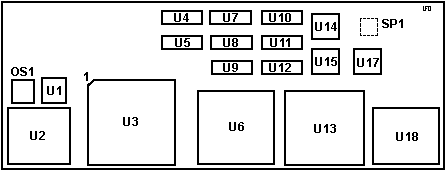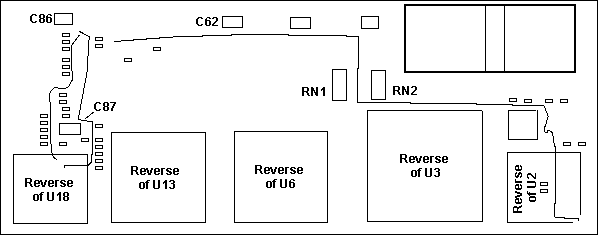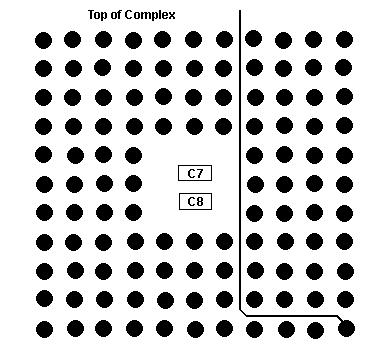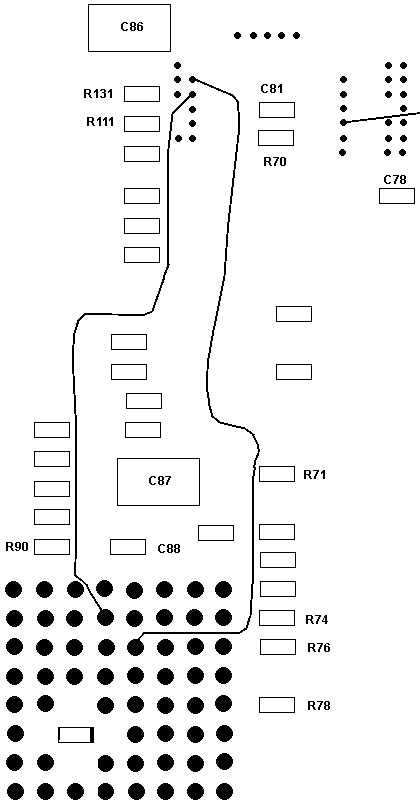Type 3 Complex
Reference and Diagnostic Disks
Specifications
Memory supported, cache, features
Support for >1GB Disks as IML
Drive
False ARTIC Diag Error
Type 3 Evergreen cpu upgrade that worked
"M"/ Upgrade 486DX 50 MHz 57F1597
Daughtercard
Why DX50 is
on a Daughtercard
Downlevel
Complex Incompatible with some Streamers
Daughtercard
Rework
Rework
on Right
Rework
on Left
Base Board
Diagnostic LEDs
192-101
IBM PS/2 Enhanced 486/50 Processor Upgrade
Reference and
Diagnostics
Reference
Disk for Type 3-
Diagnostics
for Type 3 (Common to all complexes)
Specifications
Memory
Min/Max on system board: 8/64MB (parity or ECC same limits)
PS/2 72-pin SIMM, (ECC or Parity) Interleaved SIMMs ONLY.
The PS/2 Enhanced 486/50 Processor Upgrade Option supports
a maximum of 64MB of ECC or parity memory, addressable by DMA. The
PS/2 Enhanced 486/50 Processor Upgrade Option supports 1MB and 2MB 85ns
memory, 2MB, 4MB and 8MB 80ns memory and 4MB and 8MB ECC 70ns memory.
The memory SIMMs must be installed in matched pairs (speed, size and type).
ROM: 128kb
Cache: 8kb L1, 256kb L2 cache
* 40 MB per second streaming
data transfer support.
* Error Checking and Correcting (ECC)
memory controller
* 256KB Level 2 memory cache (write-through) is standard.
* 20 MHz DMA; 32 bit DMA directly addresses all memory; DMA supports
Subsystem Control Block.
* Faster bus arbitration (than Base 1) for busmaster performance.
* Enhanced Dual Path Memory
* Subsystem Control Block
enabled
* Vital Product Data
support.
* Synchronous Channel Check
support
* Data bus parity support
* A logging facility is provided (for ECC or system errors).
>1GB Drives as IML
The M complex supports >1GB drives as the IML source.
No complex BIOS upgrade is needed (or available). However, the SCSI controller
needs the enhanced SCSI BIOS of 92F2244 / 92F2245 to IML properly.
False ARTIC diag
error
SYMPTOM: When running diagnostics on the ARTIC Portmaster
Adapter/A in an 8590 or 8595 with the 486/50MHZ processor card installed,
a false 14220, E0DE error may occur.
PROBLEM ISOLATION AIDS: Check the date of the Portmaster
Adapter/A diagnostic file (DEV141.DGS) on the system reference diskette.
Files dated 1-31-90 or earlier will exhibit the symptom.
FIX: Download updated Portmaster Adapter/A option
diskette
"M"/ Upgrade 486DX
50 MHz 57F1597 FCC ID ANOIBM486B50
Sticker on Base card is 71G6207, on daughtercard 71G6190. Both
cards are silkscreened with "57F1597".
Daughtercard

OS1 50 MHz
CPU Clock
SP1 71G6205
U1 87X0079
U2 78F1639
Address Buffer
U3 486DX-50
(5v) |
U4, U5, U7-U12
L2 Cache
U6 96F1992
Data Buffer
U13, 18 L2
Cache controller Set
U14, U15, U17
TI SN74BCT 2160-12FM |
U13, U18 L2
Cache Controller
U4, U5, U7-U12
Toshiba TC55B329J-12
Why DX50 is on
Daughtercard
The DX50 *always* sits on the second card stacked on the
base-card with the MCA-connector. This is caused by the odd Intel
cache chipset, which has a limitation on the distance it can be installed
away from the CPU ... And while there was not enough room to stuff everything
on one single printboard the cpu and cache sit in the "upper floor".
Versions Incompatible
with Network Streamers
The downlevel processor card is identified by the lack
of a module in position SP1. This card may cause data loss or undetected
change in the:
Lanstreamer MC 16 PN 58G8999
Lanstreamer MC 32 PN 92F8941
Etherstreamer MC 32 PN 59G9081
Daughtercard
Rework
Dr. Jim
sez: Documenting patch wire locations is great, but remember that there
are often foil cuts associated with them. And you can't always see
all of those.
Ed.
One can dream, can't we?
I have seen one card with the older BIOS
41G9251 ('92) that has NO rework. The three DX50 I have with the new BIOS
52G9619 ('93) all have the rework. Why? Haven't a clue.

Daughtercard
Rework on Right

Daughtercard Rework
on Left

DX50 Base Board

CR1, CR2
Diagnostic LEDs
J1
Solder pads for 25 pin header
J2 Socket
for Daughtercard
OS1 40.0000
MHz MCA Bus clock
OS2 22.1184
MHz Osc- Dunno.
U1, U22 Voltage
Regulaters
U14 96F1920
Memory Data Buffer |
U15 96F1921
Memory Addr. Buffer
U23 87X0079
U25 10G7459ESD
???
U33 92F1477ESD
???
U27 41G9251
BIOS ('92)
52G9619
BIOS ('93)
U41 10G7808
DMA Controller (Type 2) |
41G9251 BIOS. Mitsubishi variant
of the 27C201, (256K x 8-bit.)
87X0079 What
is this? It's on all later complexes.
J1 Earlier versions had a
double pin-row connector at that place ... intended for the (or: one) precessor
of the Systems Management Adapter used on "high availability network servers".
Diagnostic LEDs
The 50-MHz Type 3 processor board in a 90/95 (submodel
code 28 and 29), has two LEDs; one in position CR1, and one in CR2. During
POST, CR1 should come on momentarily and CR2 should stay off. If the LEDs
work any other way, suspect that the processor board is defective.
Use the LEDs to help differentiate between a processor
board or a system board failure. If you are instructed to replace one of
the boards, and the problem still exists, replace the other board (also
reinstall the first board). (Ed. Reports
coming in make me wonder about any of this. If the board passes diagnostics,
and works normally, do you really care about the LEDs?)
> I was all set to install a power stacker 133/586 on my dx50 in the
9595-omt. I for some reason decided to RTFM while having a cuppa. they
say the powerstacker will not work with dx50. what cpu can I use to juice
up the dx50.?
Jim Shorney
Pay no attention to the manual. Set the multiplier
to x3, the cache jumper (if present) to write-through, and plug it in.
It will probably work fine.
Complex Main Page
9595 Main Page
|

